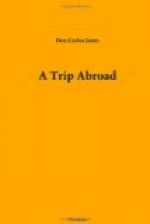The Pool of Siloam, fifty-two feet long and eighteen feet wide, is farther down the valley. The spring and the pool are about a thousand feet apart, and are connected by an aqueduct through the hill, which, owing to imperfect engineering, is seventeen hundred feet long. From a Hebrew inscription found in the lower end of this passageway it was learned that the excavation was carried on from both ends. A little below the Pool of Siloam the valley of the Kidron joins the valley of Hinnom, where, in ancient times, children were made “to pass through the fire to Moloch” (2 Kings 23:10). Job’s Well, perhaps the En Rogel, on the northern border of Judah (Joshua 15:7), is rectangular in shape and one hundred and twenty-three feet deep. Sometimes it overflows, but it seldom goes dry. When I saw it, no less than six persons were drawing water with ropes and leather buckets. The location of Aceldama, the field of blood, has been disputed, but some consider that it was on the hill above the valley of Hinnom. There are several rock-cut tombs along the slope of the hill facing the valley of Hinnom, and some of them are being used as dwelling places. The Moslems have charge of a building outside the city walls, called David’s Tomb, which they guard very carefully, and only a portion of it is accessible to visitors. Near this place a new German Catholic church was being erected at a cost of four hundred thousand dollars. We entered the city by the Zion gate, and passed the Tower of David, a fortification on Mount Zion, near the Jaffa gate.
On the ship coming down from Beyrout I had a conversation with a man who claimed to have been naturalized in the United States, and to have gone to Syria to visit his mother, but, according to his story, he was arrested and imprisoned by the Turks. After being mistreated in the filthy prison for some time, he secured his release by bribing a soldier to post a letter to one of the American authorities. He expressed a desire to visit Jerusalem, but seemed afraid to get back into Turkish territory. Learning that I was going there, he wrote a letter to the Armenian Patriarch,




